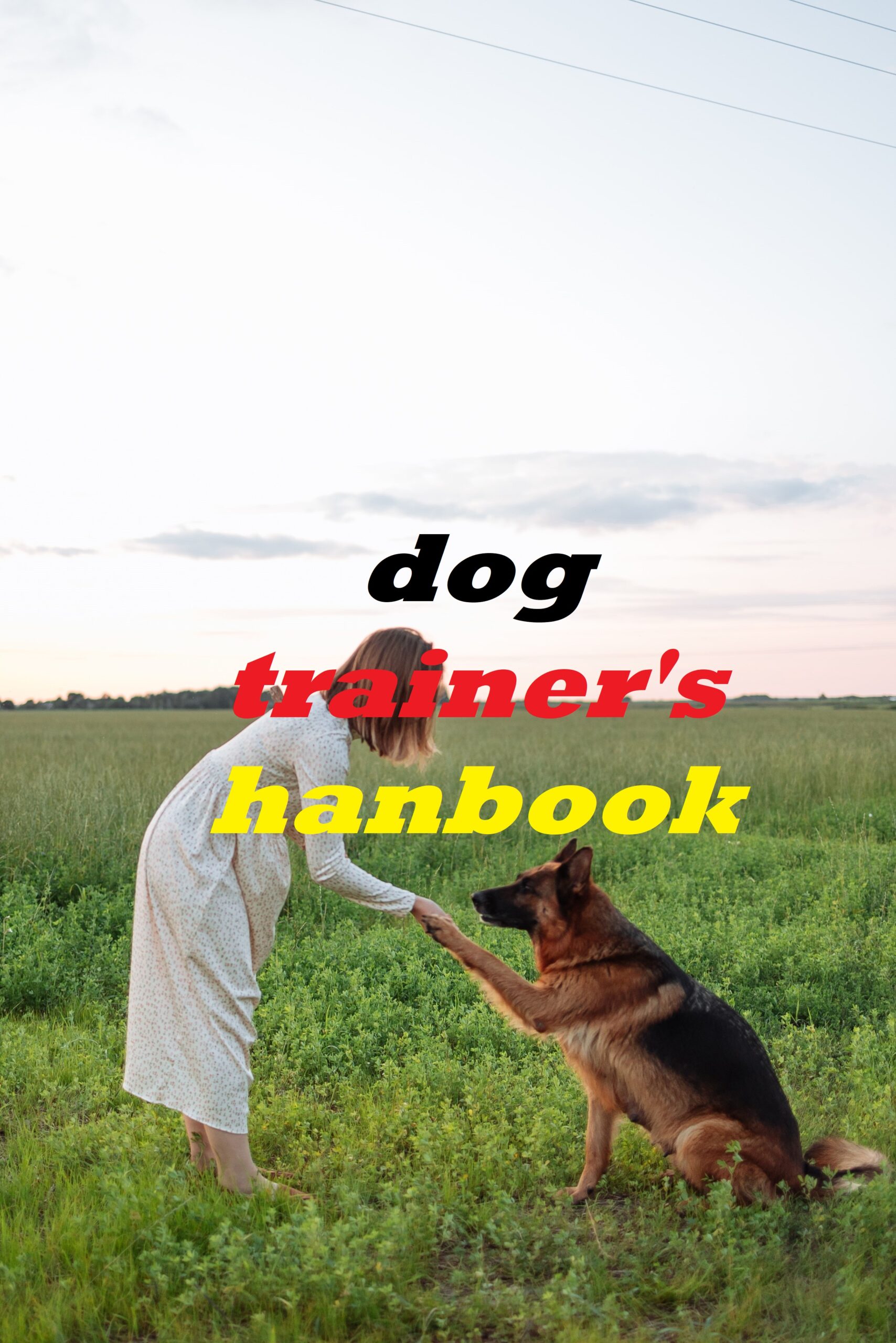Dog Trainer’s, training your dog requires patience, consistency, and positive reinforcement. Here are some general steps to follow:
***freeDIGIBOOK***Impact of Social Media on Our Lives
Start with the basics: Teach your dog basic commands like sit, stay, come, and heel. Use simple words and hand signals to communicate with your dog.
Yes, teaching your dog basic commands is a great place to start with training. Here’s how to teach your dog these commands:
Sit: Hold a treat in front of your dog’s nose, and then slowly move the treat up and back towards their tail. This should cause your dog to naturally sit down, and when they do, say “sit” and give them the treat. Repeat this several times until your dog begins to associate the command with the action.
Stay: Ask your dog to sit, and then hold your hand up in front of them with your palm facing out. Say “stay” and take a step back. If your dog stays in place, praise them and give them a treat. Gradually increase the distance and time that your dog must stay in place.
Come: Start with your dog on a leash, and then say “come” while gently tugging on the leash. When your dog comes towards you, give them a treat and praise them. Repeat this several times until your dog understands the command, and then practice off-leash in a safe, enclosed area.
Heel: Start with your dog on a leash and standing next to you. Say “heel” and start walking forward. If your dog pulls ahead or lags behind, stop and wait for them to come back to your side. Reward them with a treat when they are walking next to you.
Remember to use simple words and hand signals consistently when teaching these commands, and always reward good behavior with treats and praise. With practice and patience, your dog will soon learn these basic commands and be on their way to becoming a well-behaved companion.
Use positive reinforcement: Reward your dog with treats, praise, and affection when they exhibit good behavior. This reinforces the behavior and encourages them to repeat it.
Yes, positive reinforcement is a very effective training technique for dogs. Here are some tips on how to use positive reinforcement to train your dog:
Use treats: Treats are a great way to reward your dog for good behavior. Use small, bite-sized treats that your dog loves and give them immediately after they exhibit the desired behavior. This reinforces the behavior and encourages your dog to repeat it in the future.
Use praise: Along with treats, use verbal praise to let your dog know when they have done something good. Use a happy tone of voice and say things like “good boy/girl” or “well done”. This also reinforces the behavior and encourages your dog to repeat it.
Use affection: Dogs love affection, so use it to reinforce good behavior. Pet your dog or give them a belly rub after they exhibit good behavior. This reinforces the behavior and strengthens your bond with your dog.
Be consistent: Consistency is key when using positive reinforcement. Make sure to reward good behavior every time it occurs. This helps your dog understand that the behavior is desirable and encourages them to repeat it in the future.
Remember that positive reinforcement is a gentle and effective training technique that can help your dog learn and reinforce good behaviors. With practice and consistency, your dog will become a well-behaved and obedient companion.
Be consistent: Consistency is key in dog training. Make sure you are using the same commands and rewarding good behavior every time.
Yes, consistency is very important when it comes to training your dog. Here are some tips to help you be consistent in your training:
Use the same commands: Use the same command for each behavior you are trying to teach your dog. For example, use “sit” instead of “down” when teaching your dog to sit. Using consistent commands will help your dog understand what you are asking them to do.
Reward good behavior every time: Be sure to reward your dog every time they exhibit good behavior. This helps reinforce the behavior and encourages them to repeat it in the future.
Use the same tone of voice: Use the same tone of voice when giving commands and praise. Dogs respond well to a consistent tone of voice, so using the same tone will help your dog understand what you want them to do.
Use the same training methods: Use the same training methods each time you train your dog. This will help your dog understand what you expect of them and what behavior is desirable.
Dog trainer’s must be consistent in your training, you will help your dog learn and reinforce good behaviors. This will lead to a happier and more well-behaved companion.
Keep training sessions short: Dogs have short attention spans, so keep training sessions brief and frequent. Aim for 5-10 minutes per session, several times a day.
Yes, keeping training sessions short is very important when it comes to training your dog. Here’s why:
Attention span: Dogs have short attention spans, especially when it comes to training. Keeping training sessions short and frequent will help your dog stay focused and engaged.
Avoid frustration: Long training sessions can be frustrating for both you and your dog. By keeping sessions short, you can avoid frustration and keep the training experience positive for both of you.
Reinforcement: Short training sessions allow you to reinforce good behavior more frequently, which can help your dog learn faster and remember what they have learned.
Consistency: Short, frequent training sessions help you be more consistent in your training. You can easily fit in a few short sessions throughout the day, which will help your dog learn and reinforce good behaviors more quickly.
So, aim for 5-10 minute training sessions several times a day. This will help your dog stay focused, avoid frustration, reinforce good behavior, and lead to a more successful training experience.
Socialize your dog: Socialization is important for your dog to learn how to behave around other dogs and people. Take your dog on walks, to the dog park, or enroll them in a training class.
Yes, dog trainer’s must know socialization is very important for dogs. Here are some tips to help you socialize your dog:
Start early: Socialization should begin as early as possible, ideally when your dog is a puppy. This is when they are most receptive to new experiences and less likely to develop fear or aggression.
Take your dog on walks: Taking your dog on walks is a great way to socialize them. It exposes them to new people, animals, and experiences. Start with quiet areas and gradually introduce them to busier places.
Visit the dog park: Dog parks are a great place for dogs to socialize with other dogs. However, make sure your dog is up-to-date on vaccinations and is well-behaved before visiting a dog park.
Enroll in a training class: Enrolling your dog in a training class can also help with socialization. It exposes your dog to new people and dogs in a controlled environment.
Reward good behavior: Reward your dog for good behavior during socialization. This will reinforce positive behavior and help them feel more comfortable in new situations.
Remember that socialization is an ongoing process, and it’s important to continue exposing your dog to new experiences throughout their life. With proper socialization, your dog will become a well-adjusted and friendly companion.
Be patient: Training takes time and effort. Don’t get frustrated if your dog doesn’t learn a command right away. Keep practicing and be patient.
Yes, patience is key when it comes to training your dog. Here are some tips to help you be patient during the training process:
Remember that training takes time: Training your dog is not an overnight process. It takes time and effort, so don’t get frustrated if your dog doesn’t learn a command right away. Consistency and persistence are key.
Break training into smaller steps: Break down training into smaller steps and work on one step at a time. This will help your dog learn the behavior in a more manageable way and prevent frustration.
Use positive reinforcement: Use positive reinforcement to encourage good behavior. Reward your dog with treats, praise, and affection when they exhibit good behavior. This will help reinforce the behavior and encourage them to repeat it.
Keep training sessions short: As mentioned earlier, keep training sessions short to avoid frustration for both you and your dog. Short sessions help your dog stay focused and engaged, which leads to a more successful training experience.
Stay calm and patient: Dogs can pick up on their owner’s emotions, so it’s important to stay calm and patient during training. If you become frustrated or angry, it can negatively impact the training experience.
By being patient, consistent, and persistent, dog trainer’s can help your dog learn new behaviors and become a well-behaved companion.
Understand your dog’s behavior: Each dog has its own personality and learning style. Learn to understand your dog’s behavior, body language, and needs to tailor your training approach to them.
Yes, understanding your dog’s behavior is very important when it comes to training. Here are some tips to help you better understand your dog:
Observe their body language: Dogs communicate through body language. Learn to read your dog’s body language to understand how they are feeling. For example, a wagging tail can mean your dog is happy, while a tucked tail can indicate fear or anxiety.
Learn their personality: Each dog has its own unique personality. Some dogs may be more energetic, while others may be more laid back. Understanding your dog’s personality can help you tailor your training approach to them.
Identify their learning style: Dogs have different learning styles. Some dogs may learn better through positive reinforcement, while others may respond better to correction-based training. Identifying your dog’s learning style can help you choose the right training techniques for them.
Recognize their needs: Dogs have basic needs like food, water, exercise, and socialization. Recognizing your dog’s needs and meeting them can help them feel more comfortable and confident, which can make training more successful.
Seek professional help: If you are struggling to understand your dog’s behavior or need help with training, consider seeking professional help. A professional dog trainer can provide guidance and support to help you train your dog.
By understanding your dog’s behavior, dog trainer’s can tailor your training approach to them, which can lead to a more successful training experience.
Use treats effectively: Treats are a great way to reward good behavior, but they should be used strategically. Use high-value treats (like small pieces of cheese or chicken) for more challenging commands or behaviors, and gradually decrease the frequency of treats as your dog learns.
Yes, using treats effectively is important in dog training. Here are some tips to help you use treats strategically:
Use high-value treats: High-value treats like small pieces of cheese, chicken, or hot dogs can be very motivating for dogs. Use these treats for more challenging commands or behaviors to help your dog stay motivated.
Gradually decrease the frequency of treats: Once your dog has learned a behavior, gradually decrease the frequency of treats. This will help your dog become more reliable and less reliant on treats.
Use treats as a surprise: Mix up your treat-giving so your dog doesn’t become too reliant on treats. Sometimes reward with treats, sometimes with verbal praise or affection.
Use treats to reinforce good behavior: Use treats immediately after your dog performs the desired behavior to reinforce the behavior.
Don’t overuse treats: While treats are a great way to motivate and reward your dog, it’s important not to overuse them. Too many treats can lead to obesity and other health problems.
By using treats strategically, dog trainer’s can motivate your dog to learn new behaviors and reinforce good behavior, while avoiding overreliance on treats.
Don’t punish bad behavior: Punishing your dog for bad behavior (like yelling or physical discipline) can actually make the behavior worse and damage your relationship with your dog. Instead, redirect their behavior to something positive and rewarding.
Yes, punishment is not an effective way to train your dog. Here are some reasons why you should avoid punishing your dog for bad behavior:
Punishment can cause fear and anxiety: Punishment can make your dog fearful and anxious, which can damage your relationship with them and make training more difficult.
Punishment doesn’t teach good behavior: Punishing your dog for bad behavior doesn’t teach them what they should be doing instead. It’s more effective to redirect their behavior to something positive and rewarding.
Punishment can make behavior worse: Punishing your dog can actually make the bad behavior worse. For example, if you yell at your dog for barking, they may interpret it as attention and continue to bark to get your attention.
Positive reinforcement is more effective: Positive reinforcement (rewarding good behavior) is a more effective way to train your dog. It encourages good behavior and helps your dog learn what they should be doing.
Instead of punishing your dog for bad behavior, dog trainer’s try redirecting their behavior to something positive and rewarding. For example, if your dog is chewing on furniture, redirect them to a chew toy instead. Remember to always use positive reinforcement to encourage good behavior.
Practice in different environments: Your dog should be able to follow commands and behave well in a variety of settings, so practice training in different environments (like at the park or in busy areas) to reinforce good behavior.
Yes, practicing in different environments is an important aspect of dog training. Here’s why it’s important and how to do it:
Reinforces good behavior: Training in different environments helps your dog understand that good behavior is expected in all settings, not just at home. It reinforces the commands they’ve learned and helps them apply those commands in different situations.
Increases reliability: By practicing in different environments, you can help your dog become more reliable in following commands. They will learn that the command “sit” means the same thing whether they’re at home, at the park, or in a busy area.
Helps your dog feel comfortable in new places: Dogs can become anxious in new environments, so practicing in different locations can help them feel more comfortable and confident in new places.
To practice in different environments, dog trainer’s start with easy commands in a familiar environment (like at home), and gradually work up to more challenging commands in different settings. For example, start by practicing “sit” and “stay” at home, then move to practicing in your backyard, then in a quiet park, and eventually in a busy public area. Remember to reward good behavior and use positive reinforcement.
Use positive language: Use positive language and a cheerful tone of voice when training your dog. This will make the training more enjoyable for both you and your dog.
Yes, using positive language and a cheerful tone of voice is an important aspect of dog training. Here’s why it’s important and how to do it:
Builds a positive relationship: Using positive language and a cheerful tone of voice can help build a positive relationship between you and your dog. This can make training more enjoyable for both of you and encourage your dog to learn.
Encourages good behavior: Dogs respond well to positive reinforcement, so using positive language and a cheerful tone of voice can encourage good behavior and help your dog learn faster.
Reduces stress: Dogs can sense your emotions, so using a calm and positive tone can help reduce your dog’s stress and anxiety during training.
Dog trainer’s, use positive language and a cheerful tone of voice, try using short, simple phrases like “good boy” or “good girl” when your dog exhibits good behavior. Use a high-pitched, happy tone of voice to indicate when your dog is doing something well. Avoid using negative language, like “no” or “bad dog”, as this can be confusing for your dog and may make them anxious or fearful. Dog trainer’s, Remember to always use positive reinforcement to encourage good behavior.
Keep your expectations realistic: Remember that your dog is not a human and cannot understand complex concepts like right and wrong. Keep your expectations realistic and be patient as your dog learns.
Yes, keeping your expectations realistic is an important aspect of dog training. Here’s why it’s important and how to do it:
Avoid frustration: Dogs cannot understand complex concepts like humans can. So, having unrealistic expectations can lead to frustration and disappointment. You should be patient and realistic about what your dog can learn and how long it may take.
Celebrate small successes: Keep in mind that every dog learns at their own pace. Celebrate your dog’s small successes, as this will help them build confidence and trust in you as their trainer.
Focus on improving behavior: Instead of expecting your dog to be perfect, focus on improving their behavior over time. This means setting small, achievable goals and working towards them in a step-by-step process.
To keep your expectations realistic, start with simple commands like “sit” and “stay” before moving onto more complex ones. Celebrate your dog’s small successes, and focus on the progress they make rather than the mistakes they make. Remember, training is a process, and with patience and consistency, your dog can learn and improve their behavior.
Here are some examples of how to keep your expectations realistic in dog training:
1. If you have a puppy, don’t expect them to be fully potty-trained overnight. It takes time and consistency to teach them where it’s appropriate to go. Set small goals, like getting them to go outside at specific times during the day, and reward them when they do.
2. If your dog has a bad habit, like jumping on people, don’t expect them to stop immediately. Set small goals, like getting them to sit calmly when people come over, and work on reinforcing that behavior.
3. If you’re teaching your dog a new trick, like rolling over, don’t expect them to get it right away. Break the trick down into smaller steps, like getting them to lie down, and gradually build up to the final trick.
4. When training your dog to walk on a leash, don’t expect them to immediately walk perfectly beside you without pulling. Start by getting them used to wearing a leash and collar, then work on getting them to walk calmly beside you for short distances before gradually increasing the distance and duration of your walks.
5. If your dog has separation anxiety, don’t expect them to stop being anxious when you leave the house right away. Start by leaving them alone for short periods of time, gradually increasing the amount of time you’re away. Reward them when they stay calm while you’re gone, and seek the help of a professional trainer or behaviorist if needed.
6. When teaching your dog a new command, like “come,” don’t expect them to respond perfectly every time. Practice the command in different environments and with different distractions, like other dogs or people, and reward them for coming to you even if it takes them a few tries.
Remember that every dog is different, and some may learn faster than others. By keeping your expectations realistic and focusing on small, achievable goals, you can help your dog build confidence and learn at their own pace.
Remember, training your dog is a lifelong process. Be consistent and patient, and you will build a strong bond with your furry companion while teaching them how to behave in a positive way.
By following these tips and being consistent in your training, dog trainer’s help your dog become a well-behaved and obedient companion.
While certain breeds may have some tendencies towards certain behaviors, the speed and ease of training a dog depend on several factors, including the individual dog’s personality, temperament, and motivation.
However, some dog breeds are known for being highly trainable and quick learners, such as:
1. Border Collies: Known for their intelligence and high energy, Border Collies excel in obedience training and agility sports.
2. Labrador Retrievers: Friendly and eager to please, Labs are quick learners and excel in obedience and service training.
3. Poodles: Highly intelligent and versatile, Poodles are known for their ability to learn quickly and excel in obedience training, agility, and other activities.
4. German Shepherds: Smart and obedient, German Shepherds are often used as police and military dogs and excel in obedience and protection training.
5. Golden Retrievers: Friendly and obedient, Golden Retrievers are quick learners and excel in obedience, agility, and service training.
6. Australian Shepherds: Smart and energetic, Australian Shepherds are often used for herding and excel in obedience and agility training.
7. Doberman Pinschers: Intelligent and loyal, Doberman Pinschers are known for their trainability and excel in obedience and protection training.
8. Shetland Sheepdogs: Agile and intelligent, Shetland Sheepdogs are often used in herding and excel in obedience and agility training.
Dog trainer’s, it’s important to remember that each dog is an individual and may learn at their own pace, regardless of breed. With patience, consistency, and positive reinforcement, any dog can learn and succeed in training.
Again, while these breeds may have some tendencies towards certain behaviors and abilities, each individual dog is unique and may have their own strengths and weaknesses when it comes to training. It’s important to approach training with patience, consistency, and positive reinforcement, regardless of breed.




